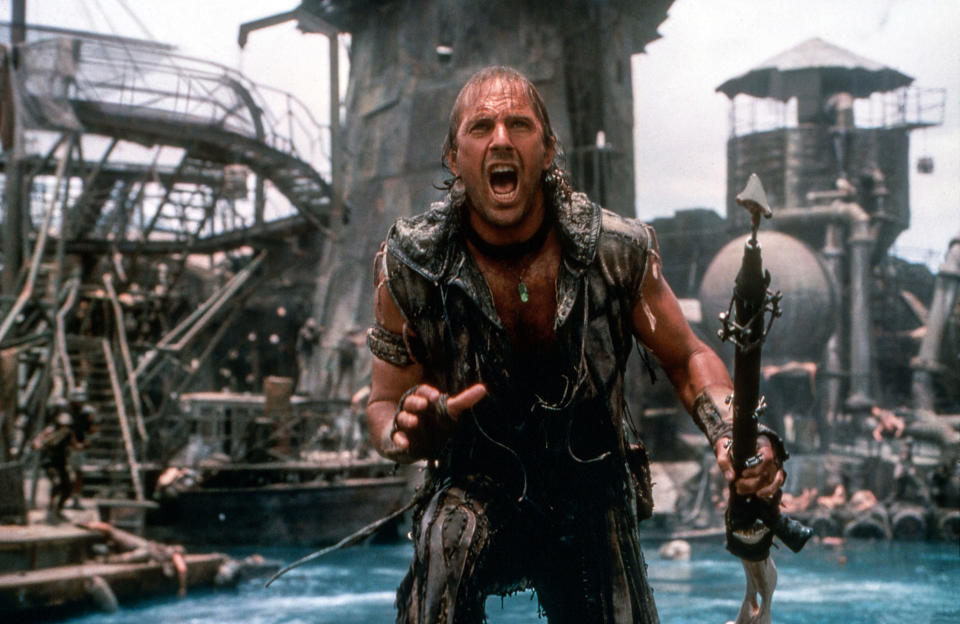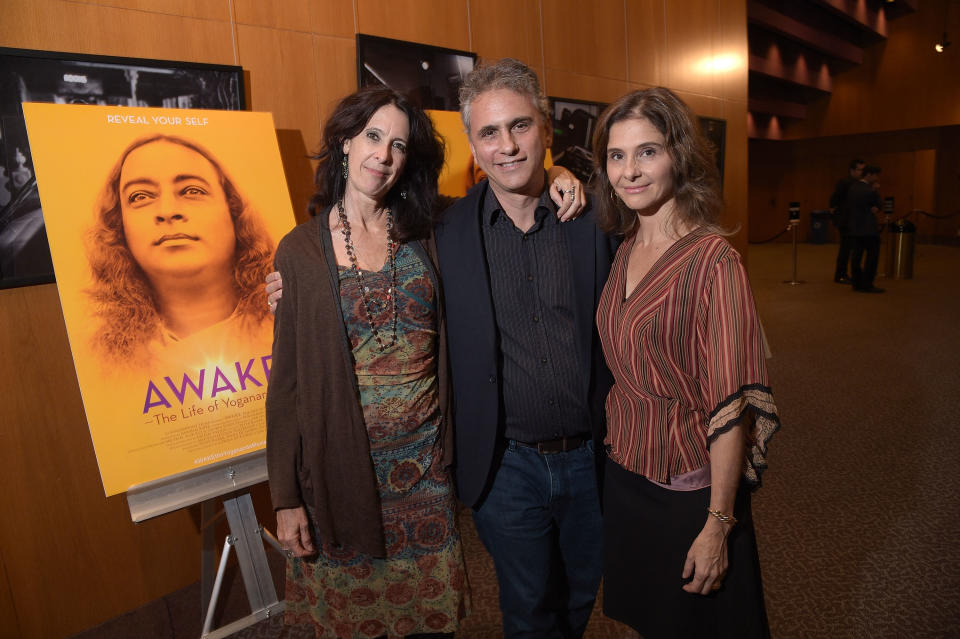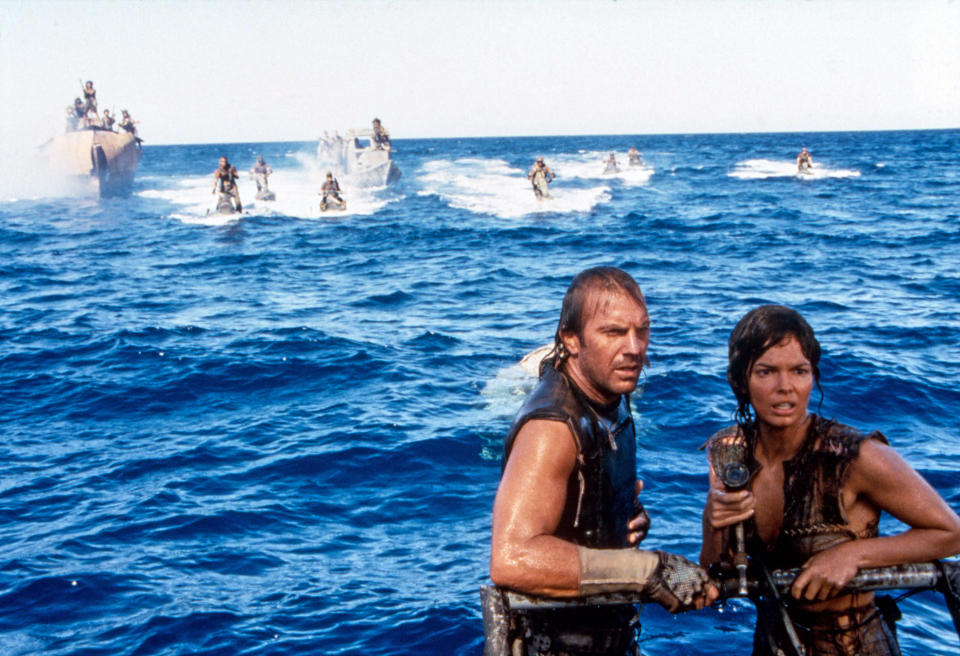'Waterworld' at 25: How Kevin Costner made one of the most expensive movies ever
Memo to all aspiring filmmakers: When Steven Spielberg tells you not to do something, you’d be wise to listen.
Kevin Costner and Kevin Reynolds learned that lesson the hard way during the production of their 1995 action epic, Waterworld. Set in a dystopian tomorrow where the polar ice caps have melted, erasing “dryland” and bathing the world in water, the movie was conceived as an ambitious aquatic Western with a science-fiction twist. But when Waterworld washed ashore in cinemas 25 years ago this summer, all anyone could talk about was the out-of-control budget and behind-the-scenes creative battles that culminated with Costner replacing Reynolds in the editing room.
According to Waterworld screenwriter, Peter Rader, the source of the movie’s many troubles stemmed from one fateful decision: the choice to shoot the entire film on the open water rather than in a controlled environment like a studio water tank. (Watch our video interview above.)
“The complications of producing this movie in a practical environment were staggering,” Rader tells Yahoo Entertainment ahead of the film’s silver anniversary on July 28. The writer adds that Spielberg — who barely survived his own trial by water during the legendarily difficult production of his 1975 blockbuster Jaws — warned Reynolds of those complications during a pre-production phone call.
Read more: Films that lost their stars a fortune
“Kevin said, ‘Steven, I’m doing this Waterworld movie, and we’re shooting on water. Do you have any advice for me?’ And Spielberg was unequivocal: ‘Do not shoot on water! You’re going to need a couple of shots on water, so use second unit for that. Do all of your coverage in a tank or a stage.’”

Despite Spielberg’s dire warnings, Reynolds and Costner decided to forge ahead with their plans to shoot on the Pacific Ocean waters in and around Hawaii. “Kevin Reynolds had this vision — and Costner supported him — which was that if we want to make this feel gritty and real, we have to do it on the water itself,” Rader explains.
But things started to go wrong from the very beginning of the shoot, when a hurricane swept through the area and destroyed the pricey floating set that served as the primary location for the first act: a lonely atoll where Costner’s seafaring Mariner encounters a small outpost of humans — including his eventual traveling companions Helen (Jeanne Tripplehorn) and Enola (Tina Majorino) — that’s attacked by an army of oil-guzzling “smokers” led by The Deacon (Dennis Hopper).
“I visited the set three weeks into production, and I was so excited,” Rader remembers. “[But] everyone was glaring at me… and I was like ‘What did I do?’ It was because the atoll had sunk and they had to reconstruct the whole set. It was starting to balloon into a disaster.” It didn’t help that Costner was having personal issues that exacerbated his tension with Reynolds.

“Costner was having to carry the movie, while his marriage was falling apart,” Rader says. “I was in peripheral contact with various producers [during production], and they would share stories at various points. I was also reading stuff in the press and it appeared like Costner took over the editing and locked [Reynolds] out. And Kevin [Reynolds] just left Hollywood at that point.”
In the end, Waterworld ended up shooting for 166 days at a then-staggering cost of $175 million, making it the most expensive movie ever made at the time. And the press delighted in cataloguing its many miseries as the release date approached. “It’s almost like circling sharks,” Rader says. “They decided to pummel the movie.”
Read more: What happened to Kevin Costner?
Funnily enough, all that negative press paid off: Waterworld topped the box office charts during its opening weekend, and while it fell short of crossing the $100 million line domestically, it earned close to $200 million worldwide. “When it came out, people were like ‘This movie isn’t so bad — it’s pretty good!’” Rader recalls. The writer had another reason to be pleased with the film’s release: He met his future wife two weeks before the premiere. “She had press credentials, and had seen it before me,” he says, laughing.

In the 25 years since the movie’s release, Waterworld has enjoyed a long shelf life as a home video and cable television staple, as well as a perennial theme park attraction at Universal Studios Hollywood. And there’s a chance we may return to “dryland” one day: Asked whether he hoped to be involved with a Waterworld sequel or reboot, the writer declined to comment — which suggests that very pitch might be working its way through Universal’s development process.
“Waterworld is very dear to my heart,” Rader says. “It tracks with my own personal narrative: I wrote the original draft in 1986, put it on a shelf for awhile, dusted it off and it ended up being the first script I sold. Then I got an agent, a manager, a two-picture deal and it led to the production of the most expensive movie of all time! And in the year of its release, I met my wife, who I’m still married to. It’s all part of the crazy ride that was Waterworld.”
To mark the film’s 25th anniversary, Rader shared some other stories from that crazy ride including Waterworld’s origins as a Mad Max rip-off and how he made theme park history.
Mad Max meet Mad Morgan

When Rader arrived in Hollywood in the early 1980s, George Miller’s 1979 hit Mad Max and its 1981 sequel, The Road Warrior, were the low-budget, high-grossing template every independent studio hoped to copy. “I was trying to bust into Hollywood by any means possible, and I had some buddies working for Roger Corman,” Rader says, adding that he never met with the legendary B-movie producer directly, but did sit down with his then-“money man,” Brad Krevoy.
“I had a meeting with Brad, and he said, ‘Here’s the deal: If you write me a Mad Max rip-off, I will let you direct it,’” Rader remembers. “I thought about it, and decided that I wasn’t willing to just rehash that genre without some kind of cool variation. I was doing some sailing at the time, and I was like ‘Let’s set it on water!’” That idea sparked Rader’s creative imagination, but it also marked the end of his association with Corman’s money guy, who immediately dismissed a water-based premise as too expensive. “I said, ‘You know, I still like that idea a lot — I’m going to write it!’ Little did I know that it would become the most expensive movie in history.”
The star of Rader’s early drafts of Waterworld was a loner named Morgan rather than Max. “I have to confess I was thinking of Harrison Ford,” he reveals. And in a major departure from the finished film, Morgan isn’t the human/fish hybrid that Costner eventually played in Waterworld.
“That was one of the brilliant additions of the writers who came after me,” Rader explains. “I was writer number one of five, and the most significant contributions came from David Twohy. He had this idea of creating this mutation who would have webbed feet and gills. I thought that was brilliant and added a whole new level to the character I hadn’t conceived of initially.”
A horse and his sailor

Rader eventually wrote seven drafts of Waterworld before he was replaced by a series of writers that included Twohy and Joss Whedon. One of those drafts can be found online, and it features some fascinating departures from the theatrical version. For example, Morgan’s boat came equipped with... a horse. “From a genre point of view, Waterworld is a Western,” the writer says. “So having a horse on the boat was an homage to that. I also wanted to create that idea of something that was so absurd: Like, where did he find that horse? How’s he keeping it alive? Those questions were all posed by that visual image.”
Rader’s original script also featured extensive allusions to Greek and biblical mythology, a tragic backstory for Morgan and additional sidekicks who got eliminated from the narrative when it became a Costner star vehicle. “The way that I found out that Kevin was attached was that a friend of mine passed by him when he was talking to another guy, and picked up on one word. I called my agent at CAA immediately and said, ‘Kevin Costner is interested in Waterworld?’”
Unfortunately, Costner’s involvement also signalled the end of Rader’s time with the script. “I was so naive as a writer... I actually hadn't even conceived of the idea that I could be replaced,” he says. While he never got to meet Costner face to face, he does credit Reynolds with picking up the phone and talking through the script. “Kevin got my intention. He tuned into the fact that it’s a popcorn movie, but we could also say a couple of things about the environment and how we’ve been treating the Earth.”
Reynolds also preserved one of Rader’s favourite scenes in his version of the script: the revelation that the hero converts his urine into drinking water via a handmade filtration device. “That never changed in any of the drafts. It sets up the world in one scene: If you’re on a boat in the middle of nowhere and a guy drinks a filtered version of his own urine, you know what the stakes are.” (For the record, there is one crucial difference between the urine conversion device described on the page and seen onscreen: In Rader’s script, it features a working kidney.)
Don’t just watch Waterworld — visit it

Three months after Waterworld sailed into cinemas, Universal Studios Hollywood debuted the spectacular stunt show Waterworld: A Live Sea War Spectacular, which recreated the movie’s atoll attack. Twenty-five years later the show is still running several times a day. (When the park is open, that is: Like many theme parks, Universal Studios is currently closed due to the coronavirus pandemic.) “I’ve seen it half-a-dozen times,” Rader says. “My favourite part is when the sea plane crashes into the arena and splashes over everyone.”
In a sign of the movie’s international staying power, versions of the show can also be seen at Universal Studios Japan and Universal Studios Singapore. And the soon-to-open Universal Studios Beijing has even bigger plans for Waterworld. “Waterworld has its own zone, like Harry Potter or Jurassic Park,” Rader says of the China-based theme park, which is scheduled to open to the public in 2021, although COVID-19 could delay that date. “I think that’s for two reasons: The movie made an impression that has never gone away, and it’s also the perfect storm of entertainment elements, especially for a theme park. So absolutely, let’s make it a whole zone!”
Interestingly, Rader reveals that he and Twohy helped make both cinematic and theme park history when they teamed up for a pioneering court case that has allowed screenwriters to receive compensation when their films are adapted into theme park attractions.
“After the release of the movie, the Writers Guild approached us and said, ‘We can use Waterworld as a test case to set a precedent,’” he explains. “It took us a really long time, but we did prevail. We demanded to see a transcript of the actual stunt show... which was basically a 20-minute version of our work. We did an analysis of the script, and David came up with a block of dialogue from a paragraph that was not in the final movie. It was an unused draft verbatim. So they had proof, and now writers get a minimum guarantee if their work is exploited in a theme park.”
Change the climate, change the world
Thanks to environmental activists like Greta Thunberg — and the unpopular policies of President Donald Trump’s administration — climate change is a hot topic among America’s younger generations. For them, Waterworld isn’t just a movie: It’s a dire warning call of a world to come. And Rader is on their side. “I really admire Greta Thunberg,” he says. “She recently called on leaders and said, ‘Look, the way we're responding to COVID-19, can we apply that to the fricking planet, please?’ We can do this, so let’s do it together.”
The writer says he was an early adopter to climate change warnings, which provided part of the inspiration for Waterworld. “I wrote the original draft in 1986 very much thinking about that. We didn’t have Google at the time, but if you went to any library you could easily find out that if all the ice melted, the sea would rise — not to Waterworld levels, but it’s a movie. I like to have a modicum of scientific plausibility.”
Since the movie’s release, Rader has had the opportunity to participate in actual scientific discussions about climate change’s impacts on our planet. “I was recently invited to the United Nations for a roundtable with Under-Secretary-General and a whole bunch of engineers, architects and ecologists to explore the idea of floating cities,” he says, referring to a 2019 U.N. event. “It was a wild conversation! They had a model that looked just like the atoll from Waterworld.” Costner has also done his part for the planet; in the wake of Waterworld, the actor invested in oil separating machines, which wound up being employed to fight the Deepwater Horizon oil spill in 2010. “That [technology] was in one of my very early drafts,” Rader says, laughing. “I should probably ask him for some royalties or something because he definitely got the idea from the script.”
Waterworld is currently streaming on Netflix.
— Video produced by Gisselle Bances

 Yahoo Home
Yahoo Home 
